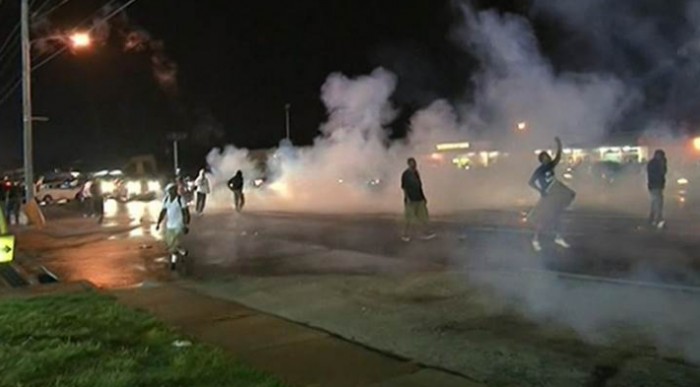
There was a chill in the air on Wednesday night in Ferguson as protesters paid tribute to Michael Brown through candlelight vigil and prepped for a flurry of activity that is expected this coming weekend.
Protesters shifted from their primary position in front of the local police headquarters to the scene of another shooting of a black teenager, this time by an off-duty St. Louis police officer, overnight on Wednesday. St. Louis police scanners reported that 125 people blocked an intersection in the area, but remained peaceful. According to the police scanner, the crowd was made up of “15-year-olds to 80-year-olds, all races, all genders.”
This new incident has reignited simmering tension in a region still reeling from the killing of Brown two months ago.
St. Louis police said a uniformed off-duty officer fired at least 17 shots at the teen, leaving him dead in a neighborhood a little more than a dozen miles from where Brown was killed two months ago.
St. Louis shooting heightens tensions on eve of protests
Unlike Brown, police say the teen killed Wednesday fired at an officer with a 9mm handgun, which they said was recovered at the scene. Nonetheless, the killing sparked anger and protests and drew calls for greater scrutiny of police who some believe kill young black men with impunity. The shooting occurred ahead of what organizers in Ferguson believe will be an historic weekend of protest in that city.
After more than 60 days of protests, hundreds of arrests, and through a haze of raw emotions, protesters in Ferguson, Missouri, are ramping up their calls for justice for Brown.
Organizers this week are preparing for one of the largest series of demonstrations since Brown’s killing by a Ferguson police officer on Aug. 9. This weekend, in what’s being billed as a “Weekend of Resistance,”several thousand protesters from around the country are expected to arrive in Ferguson between Friday, Oct. 10 and Monday, Oct. 13 for daily rallies, marches and acts of civil disobedience.
Brown’s shooting sparked sporadic looting and spontaneous protests that drew thousands to the city’s streets in sometimes violent clashes with heavily-armed police. The efforts have since evolved into sustained, peaceful protests and a much more organized movement around clear goals and political ideals, not the least of which are calls for an arrest of Brown’s killer, officer Darren Wilson.
“The mobilization this weekend is our attempt to connect justice for Michael Brown with a budding national movement against police violence across the country,” said Mervyn Marcano, a spokesman for Ferguson October, a mobilization effort organized by Hands Up United, the Organization for Black Struggle and hundreds of other local and national groups. “We are hopeful that people will come here and be energized by the movement in Ferguson and take that work back into their cities across the country.”
In the two months since Brown’s killing, this small St. Louis suburb has gone from largely anonymous to infamous. Brown’s shooting death and the fiery response from the predominantly black protesters and predominantly white police unsheathed a long, sometimes nasty history of racial discord in the region.
Witnesses say Brown, who was black, was shot and killed by Wilson, who is white, as Brown attempted to flee. The final, fatal shots came as Brown attempted to surrender with his hands up, witnesses say. Police say Wilson shot Brown during a fight for Wilson’s weapon.
In the shadow of the killing and the social tumult that unfurled from it, an at-times unwieldy series of protests have congealed into something much more organized and far beyond what many protesters had imagined.
While daily demonstrations draw only dozens compared to the mass protests in the earliest days, the protesters seem to have thinned to a core, committed group. Nearly every night, protesters have gathered across the street from Ferguson police headquarters. They’ve interrupted the St. Louis Symphony Orchestra and clashed with St. Louis Cardinal Baseball fans during a recent playoff game and per the ubiquitous “No Justice, No Peace,” chant heard around Ferguson, activists have committed to further acts of civil disobedience to disrupt the status quo.
“The mobilization this weekend is our attempt to connect justice for Michael Brown with a budding national movement against police violence across the country.”MERVYN MARCANO, A SPOKESMAN FOR FERGUSON OCTOBER
“The movement is more organized now. In the beginning we didn’t know what we were doing and nobody expected this to happen but we’ve grown into a real movement,” said Johnetta Elzie, who has been protesting since the day after Brown’s death. “I feel like this one moment is giving birth. Mike Brown Jr. started a birth of so many different levels of the movement where people are just becoming more aware and awakened to the injustices that are happening,”
Taurean Russell, one of many young protest leaders that have emerged, said he has watched as the street-level movement directly linked to the shooting has spread.
“I’ve connected with people in 22 states about joining the movement. I’ve had a woman from France and another woman from Brazil reach out,” Russell said. “It’s a national movement but people on the global scene are interested in what we’re doing here in Ferguson.”
Organizers of the weekend’s mobilizations say a broad spectrum groups are expected to take part in demonstrations, including some organized by church groups, on college campuses and unaffiliated people who’ve been looking for a way to support the protests. A message board for those looking to hitch rides to Ferguson or find lodging boasts inquiries from a number of states across the country.
The ramped up efforts come as a grand jury is mulling whether or not to charge Officer Wilson in Brown’s death. Many on the ground say they have little faith in the grand jury and St. Louis County Prosecutor Bob McCulloch who convened the jury. Many believe the grand jury will not indict Wilson largely because of McCulloch’s historic failure to secure indictments of white officers who shoot unarmed black suspects and because of the odd manner in which he has overseen the grand jury’s deliberations.
Federal, state and local officials have reportedly been meeting behind closed doors to develop an emergency response plan for the city if the jury does not indict Wilson, a move critics say has fueled lingering tension on the streets.
Last week, St. Louis County police took over command of crowd control operations from Ferguson police citing manpower and resource limitations. The change came a day after Ferguson police arrested a dozen protestors for the rather vague charges of language to incite violence, noise violations and resisting arrest.
Earlier this week a federal judge issued an injunction barring police from enforcing what became widely known as the “5-second rule,” in which protesters faced arrest if they stood still in any one place for longer than five seconds.
Since protests in Ferguson began, well over 200 protesters have been arrested, a number of people multiple times.
“Citizens who wish to gather in the wake of Michael Brown’s tragic death have a constitutional right to do so, but they do not have the right to endanger lives of police officers or other citizens,” U.S. District Court Judge Catherine Perry wrote in her ruling, finding the tactic unconstitutional because it violated protesters’ freedom of speech rights, as well as due process.“The police must be able to perform their jobs, and nothing in this order restricts their ability to do that.”
This weekend will be a major test for local law enforcement, as officials have blamed out of town protesters and anarchist for much of the early violence during clashes between protesters and the police. But the mere presence of officers in riot gear and armed with automatic weapons, aggressively posturing, seemed to spur as much outrage among protesters as anything else.
On Wednesday afternoon, Attorney General Eric Holder joined former President Bill Clinton at a meeting of the U.S. Conference of Mayors in Arkansas to discuss the many lessons learned from the ongoing unrest in Ferguson. Since Ferguson erupted, Holder has visited the city and met with residents and city leaders. He has also called for a large-scale, national review of police bias, techniques and racial profiling.
The Justice Department currently has two open investigations in Ferguson, one on the Brown case and the other looking into the entire Ferguson police department.
“The events in Ferguson reminded us that we cannot and we must not allow tensions, which are present in so many neighborhoods across America, to go unresolved,” Holder said at the meeting.
JOSE DIAZ-BALART, 10/8/14, 10:47 AM ET
Ferguson and community policing discussions
Meanwhile, back in Ferguson, as Brown’s parents have renewed calls for Wilson’s immediate arrest, organizers have laid out an ambition series of demonstrations beginning Friday and ending Monday. The first scheduled action on Friday is a protest rally outside of McCulloch’s office in Clayton to demand that he recuse himself from the case. Another rally is scheduled for Saturday, this one in downtown St. Louis and billed as a “Justice for All” national march. On Sunday, hip hp artists, activists and faith leaders will join forces for a “Hip Hop and Hope” day of action, and the weekend’s events are scheduled to conclude on Monday with widespread civil disobedience actions throughout Ferguson and the St. Louis region.
“The main inspiration that has everyone so together is that Mike Brown Jr. laid out in the street for more than four hours and you can still see his blood right there stained in the street,” said Johnetta Elzie. “If you look past the roses laid out where he died his blood is still there, he is still there.”
“We are steadfast,” she added. “This was an awakening.”

